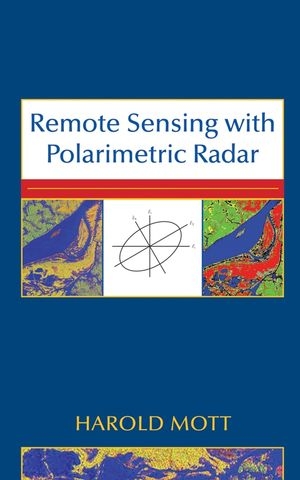
Remote Sensing with Polarimetric Radar
Wiley-IEEE Press (Verlag)
978-0-470-07476-3 (ISBN)
Discover the principles and techniques of remote sensing with polarimetric radar This book presents the principles central to understanding polarized wave transmission, scattering, and reception in communication systems and polarimetric and non-polarimetric radar. Readers gain new insight into the methods for remotely gathering data about the earth's surface and atmosphere with polarimetric synthetic-aperture radar and polarimetric interferometry, including the changes that take place with seasons, floods, earthquakes, and other natural phenomena. In particular, with the book's focus on polarimetric radars, readers discover how to exploit the many special features of these systems, which provide the maximum amount of information that can be obtained remotely with radar.
Introductory-level coverage of electromagnetic wave propagation, antennas, radar and synthetic aperture radar, probability and random processes, and radar interferometry serves as a foundation for advancing to more complex material. A more advanced mathematical and technical treatment enables readers to fully grasp polarized wave transmission, propagation, and reception in communication systems and polarimetric-radar remote sensing. Readers will discover much new material in this text, including:
Distinguishing between coherently-measured and incoherently-measured target matrices for power, recognizing that the two matrix types are not equivalent in representing targets
Removing unpolarized components from the scattered wave and deriving a target matrix for classification from the resulting coherently-scattered wave
Selecting an antenna polarization to maximize the contrast between desired and undesired depolarizing targets
Problems ranging in complexity from introductory to challenging are presented throughout the text.
Engineers will find this an ideal reference to help them fully utilize the powerful capabilities of polarimetric radar. It will also help agronomists, geographers, meteorologists, and other scientists who use remotely obtained data about the earth to evaluate procedures and better interpret the data. The book can also be tailored to both undergraduate and graduate courses in remote sensing, and recommendations are given for text material suitable for such courses.
HAROLD MOTT, PhD, is Professor Emeritus of Electrical Engineering at the University of Alabama. Dr. Mott has carried out polarimetric-radar research for NASA and NRL, and has consulted extensively with the Army Missile Command on radar environmental modeling. He is the author of Polarization in Antennas and Radar and Antennas for Radar and Communications: A Polarimetric Approach (both published by Wiley).
Preface xii
Acknowledgments xv
1. Electromagnetic Waves 1
1.1. The Time-Invariant Maxwell Equations 2
1.2. The Electromagnetic Traveling Wave 3
1.3. Power Density 6
1.4. The Polarization Ellipse 7
1.5. Polarization Vector and Polarization Ratio 11
1.6. Circular Wave Components 11
1.7. Change of Polarization Basis 12
1.8. Ellipse Characteristics in Terms of P and Q 14
1.9. Coherency and Stokes Vectors 15
1.10. The Poincaré Sphere 17
References 19
Problems 19
2. Antennas 21
2.1. Elements of the Antenna System 21
2.2. The Vector Potentials 22
2.3. Solutions for the Vector Potentials 24
2.4. Far-Zone Fields 25
2.5. Radiation Pattern 28
2.6. Gain and Directivity 30
2.7. The Receiving Antenna 34
2.8. Transmission Between Antennas 41
2.9. Antenna Arrays 41
2.10. Effective Length of an Antenna 47
2.11. Reception of Completely Polarized Waves 48
2.12. Gain, Effective Area, and Radiation Resistance 51
2.13. Maximum Received Power 52
2.14. Polarization Efficiency 52
2.15. The Modified Friis Transmission Equation 54
2.16. Alignment of Antennas 54
References 57
Problems 57
3. Coherently Scattering Targets 59
3.1. Radar Targets 59
3.2. The Jones Matrix 61
3.3. The Sinclair Matrix 62
3.4. Matrices With Relative Phase 64
3.5. FSA–BSA Conventions 65
3.6. Relationship Between Jones and Sinclair Matrices 65
3.7. Scattering with Circular Wave Components 66
3.8. Backscattering 67
3.9. Polarization Ratio of the Scattered Wave 68
3.10. Change of Polarization Basis: The Scattering Matrix 68
3.11. Polarizations for Maximum and Minimum Power 70
3.12. The Polarization Fork 77
3.13. Nonaligned Coordinate Systems 81
3.14. Determination of Scattering Parameters 82
References 88
Problems 89
4. An Introduction to Radar 91
4.1. Pulse Radar 92
4.2. CW Radar 98
4.3. Directional Properties of Radar Measurements 98
4.4. Resolution 99
4.5. Imaging Radar 104
4.6. The Traditional Radar Equation 105
4.7. The Polarimetric Radar Equation 107
4.8. A Polarimetric Radar 108
4.9. Noise 110
References 117
Problems 117
5. Synthetic Aperture Radar 119
5.1. Creating a Terrain Map 119
5.2. Range Resolution 124
5.3. Azimuth Resolution 125
5.4. Geometric Factors 132
5.5. Polarimetric SAR 133
5.6. SAR Errors 133
5.7. Height Measurement 136
5.8. Polarimetric Interferometry 141
5.9. Phase Unwrapping 142
References 147
Problems 147
6. Partially Polarized Waves 149
6.1. Representation of the Fields 150
6.2. Representation of Partially Polarized Waves 154
6.3. Reception of Partially Polarized Waves 164
References 166
Problems 166
7. Scattering by Depolarizing Targets 169
7.1. Targets 170
7.2. Averaging the Sinclair Matrix 173
7.3. The Kronecker-Product Matrices 174
7.4. Matrices for a Depolarizing Target: Coherent Measurement 177
7.5. Incoherently Measured Target Matrices 178
7.6. Matrix Properties and Relationships 186
7.7. Modified Matrices 189
7.8. Names 191
7.9. Additional Target Information 191
7.10. Target Covariance and Coherency Matrices 192
7.11. A Scattering Matrix with Circular Components 196
7.12. The Graves Power Density Matrix 197
7.13. Measurement Considerations 199
7.14. Degree of Polarization and Polarimetric Entropy 200
7.15. Variance of Power 201
7.16. Summary of Power Equations and Matrix Relationships 202
References 204
Problems 204
8. Optimal Polarizations for Radar 207
8.1. Antenna Selection Criteria 207
8.2. Lagrange Multipliers 208
A. Coherently Scattering Targets 209
8.3. Maximum Power 209
8.4. Power Contrast: Backscattering 211
B. Depolarizing Targets 211
8.5. Iterative Procedure for Maximizing Power Contrast 212
8.6. The Backscattering Covariance Matrix 215
8.7. The Bistatic Covariance Matrix 216
8.8. Maximizing Power Contrast by Matrix Decomposition 217
8.9. Optimization with the Graves Matrix 218
References 222
Problems 223
9. Classification of Targets 225
A. Classification Concepts 225
9.1. Representation and Classification of Targets 226
9.2. Bayes Decision Rule 228
9.3. The Neyman–Pearson Decision Rule 231
9.4. Bayes Error Bounds 232
9.5. Estimation of Parameters from Data 232
9.6. Nonparametric Classification 236
B. Classification by Matrix Decomposition 242
9.7. Coherent Decomposition 243
9.8. Decomposition of Power-Type Matrices 245
C. Removal of Unpolarized Scattering 249
9.9. Decomposition of the D Matrix 249
9.10. Polarized Clutter 255
9.11. A Similar Decomposition 255
9.12. Polarimetric Similarity Classification 256
References 256
Problems 257
Appendix A. Fading and Speckle 259
Reference 261
Appendix B. Probability and Random Processes 263
B.1. Probability 263
B.2. Random Variables 273
B.3. Random Vectors 279
B.4. Probability Density Functions in Remote Sensing 287
B.5. Random Processes 288
References 294
Appendix C. The Kennaugh Matrix 295
Appendix D. Bayes Error Bounds 299
References 301
Index 303
| Erscheint lt. Verlag | 12.1.2007 |
|---|---|
| Reihe/Serie | IEEE Press |
| Sprache | englisch |
| Maße | 160 x 241 mm |
| Gewicht | 667 g |
| Themenwelt | Naturwissenschaften ► Geowissenschaften ► Geografie / Kartografie |
| Technik ► Elektrotechnik / Energietechnik | |
| Technik ► Nachrichtentechnik | |
| ISBN-10 | 0-470-07476-0 / 0470074760 |
| ISBN-13 | 978-0-470-07476-3 / 9780470074763 |
| Zustand | Neuware |
| Haben Sie eine Frage zum Produkt? |
aus dem Bereich


